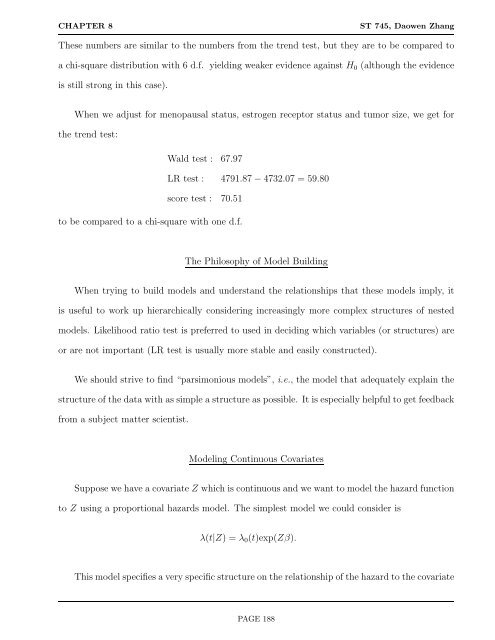8 Modeling Survival Data with Categorical ... - NCSU Statistics
8 Modeling Survival Data with Categorical ... - NCSU Statistics
8 Modeling Survival Data with Categorical ... - NCSU Statistics
Create successful ePaper yourself
Turn your PDF publications into a flip-book with our unique Google optimized e-Paper software.
CHAPTER 8 ST 745, Daowen Zhang<br />
These numbers are similar to the numbers from the trend test, but they are to be compared to<br />
a chi-square distribution <strong>with</strong> 6 d.f. yielding weaker evidence against H0 (although the evidence<br />
is still strong in this case).<br />
When we adjust for menopausal status, estrogen receptor status and tumor size, we get for<br />
the trend test:<br />
Wald test : 67.97<br />
LR test : 4791.87 − 4732.07 = 59.80<br />
score test : 70.51<br />
to be compared to a chi-square <strong>with</strong> one d.f.<br />
The Philosophy of Model Building<br />
When trying to build models and understand the relationships that these models imply, it<br />
is useful to work up hierarchically considering increasingly more complex structures of nested<br />
models. Likelihood ratio test is preferred to used in deciding which variables (or structures) are<br />
or are not important (LR test is usually more stable and easily constructed).<br />
We should strive to find “parsimonious models”, i.e., the model that adequately explain the<br />
structure of the data <strong>with</strong> as simple a structure as possible. It is especially helpful to get feedback<br />
from a subject matter scientist.<br />
<strong>Modeling</strong> Continuous Covariates<br />
Suppose we have a covariate Z which is continuous and we want to model the hazard function<br />
to Z using a proportional hazards model. The simplest model we could consider is<br />
λ(t|Z) =λ0(t)exp(Zβ).<br />
This model specifies a very specific structure on the relationship of the hazard to the covariate<br />
PAGE 188
















